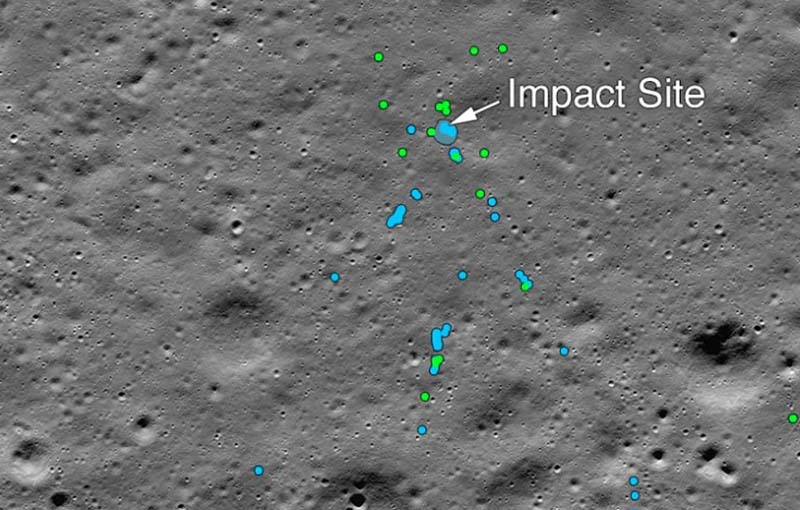NASA finds Chandrayaan-2 lander Vikram with help of Indian engineer

This image released by NASA shows the Vikram Lander impact point and associated debris field. Green dots indicate spacecraft debris (confirmed or likely). Blue dots locate disturbed soil, likely where small bits of the spacecraft churned up the regolith. “S” indicates debris identified by Shanmuga Subramanian , the Indian engineer. (Photo Credit: NASA/ Twitter)
NEW DELHI, Dec 3, 2019, Hindustan Times. Almost three months after Chandrayaan 2—India’s second mission to moon— went awry in the last 2.1km of its journey, US space agency Nasa has located the lander with the help of observation made by an Indian engineer, Hindustan Times reported.
“This image shows the Vikram Lander impact point and associated debris field. Green dots indicate spacecraft debris (confirmed or likely). Blue dots locate disturbed soil, likely where small bits of the spacecraft churned up the regolith. “S” indicates debris identified by Shanmuga Subramanian [the Indian engineer],” said the release from NASA, showing the spots on an image captured by its Lunar Reconnaissance Orbiter (LRO) on November 11.
After 48 days in Earth and lunar orbit, the Vikram lander and Pragyan rover that had been indigenously developed were to soft-land on the lunar surface on September 7.
A successful landing would have made India the fourth country to have landed on moon after the US, the erstwhile USSR, and China. India would have made India the first country to have landed so close to the lunar South Pole, where scientists suspect there is water ice.
The “hard landing” was confirmed officially by the minister of state for the department of Space Jitendra Singh in the Parliament.
“The velocity was reduced from 1,683m/s to 146 m/s. During the second phase of the descent, the reduction in velocity was more than the designed value. Due to this deviation, the initial conditions at the start of the fine braking phase were beyond the designed parameters. As a result, Vikram hard landed within 500m of the designated landing site,” Singh said in a written reply.
Nasa’s orbiter had captured the first set of images of the landing site on September 17, when it was lunar dusk in the region. Scientists from the LRO camera team had said that they were unable to identify the Vikram lander because of the long shadows in the region during dusk.
However, when these images were released to the public on September 26, Subramaniam was one of the enthusiasts who downloaded the images and started a search for India’s lander.
Shanmuga Subramaniam is a mechanical engineer and an app developer from Chennai.
“The Lunar Reconnaissance Orbiter Camera team released the first mosaic (acquired September 17) of the site on September 26 and many people have downloaded the mosaic to search for signs of Vikram. Shanmuga Subramanian contacted the LRO project with a positive identification of debris. After receiving this tip, the LROC team confirmed the identification by comparing before and after images,” read the statement from NASA.
“The LROC team scoured the surrounding area in these new mosaics and found the impact site (70.8810°S, 22.7840°E, 834 m elevation) and associated debris field,” NASA said.
The debris first located by Shanmuga is about 750 meters northwest of the main crash site.